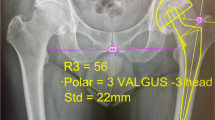Abstract
Introduction
Currently, several potential advantages lead to minimally invasive total hip arthroplasty which become popular with orthopaedic community. However, there is little comparative study on minimally invasive techniques especially through anterior approach. This investigation aimed to evaluate the efficacy of minimally invasive modified Watson–Jones approach and to compare short-term clinical results with minimally invasive modified Hardinge approach.
Methods
A consecutive series of 92 patients managed with minimally invasive total hip arthroplasty (47 with use of a modified Watson–Jones approach and 45 with use of a modified Hardinge approach) by one surgeon at one hospital were studied. All patients received the same design of cementless acetabular cup and femoral component. Data analysis included patient demographics, pre-operative diagnosis, surgical duration, intra-operative blood loss, type of anesthesia and length of hospital stay. Radiographic analysis included cup inclination angle, femoral stem alignment and leg length discrepancy.
Results
No significant differences were noticed with regard to the average surgical time, intra-operative blood loss and length of hospital stay in both groups. The average femoral component alignment and the average post-operative abduction angle of the acetabular cup were in acceptable ranges in both groups. However, the prevalence of femoral stem varus outlier was significantly high in minimally invasive modified Watson–Jones approach group.
Conclusions
The higher prevalence of varus stem outlier in minimally invasive modified Watson–Jones approach must be considered to minimize femoral stem malalignment.


Similar content being viewed by others
References
Berger RA, Duwelius PJ (2004) The two-incision minimally invasive total hip arthroplasty: technique and results. Orthop Clin N Am 35:163–172
Bertin KC, Rottinger H (2004) Anterolateral mini-incision hip replacement surgery: a modified Watson–Jones approach. Clin Orthop Relat Res 429:248–255
Demos HA, Rorabeck CH, Bourne RB, MacDonald SJ, McCalden RW (2001) Instability in primary total hip arthroplasty with the direct lateral approach. Clin Orthop Relat Res 393:168–180
Dewal H, Su E, Dicesare PE (2003) Instability following total hip arthroplasty. Am J Orthop 32:377–382
Duncan CP, Toms A, Masri BA (2006) Minimally invasive or limited incision hip replacement: clarification and classification. Instr Course Lect 55:195–197
Eksioglu F, Uslu M, Gudemez E, Atik OS, Tekdemir I (2003) Reliability of the safe area for the superior gluteal nerve. Clin Orthop Relat Res 412:111–116
Hardinge K (1982) The direct lateral approach to the hip. J Bone Joint Surg Br 64:17–19
Howell JR, Masri BA, Duncan CP (2004) Minimally invasive versus standard incision anterolateral hip replacement: a comparative study. Orthop Clin N Am 35:153–162
Kennon RE, Keggi JM, Wetmore RS, Zatorski LE, Huo MH, Keggi KJ (2003) Total hip arthroplasty through a minimally invasive anterior surgical approach. J Bone Joint Surg Am 85(Suppl 4):39–48
Kenny P, O’Brien CP, Synnot K, Walsh MG (1999) Damage to the superior gluteal nerve after two different approaches to the hip. J Bone Joint Surg Am 81:979–981
Matta JM, Shahrdar C, Ferduson T (2005) Single-incision anterior approach for total hip arthroplasty on an orthopedic table. Clin Orthop Relat Res 441:115–124
Mulliken BD, Rorabeck CH, Bourne RB, Nayak N (1998) A modified direct lateral approach in total hip arthroplasty: a comprehensive review. J Arthroplasty 13:737–747
Pai VS (2002) A modified direct lateral approach in total hip arthroplasty. J Orthop Surg (Hong Kong) 10:35–39
Picado CH, Garcia FL, Marques W Jr (2007) Damage to the superior gluteal nerve after direct lateral approach to the hip. Clin Orthop Relat Res 455:209–211
Toms A, Duncan CP (2006) The limited incision, anterolateral, intermuscular technique for total hip arthroplasty. Instr Course Lect 55:199–203
Woolson ST, Rahimtoola ZO (1999) Risk factors for dislocation during the first 3 months after primary total hip replacement. J Arthroplasty 14:662–668
Yuan L, Shih C (1999) Dislocation after total hip arthroplasty. Arch Orthop Trauma Surg 119:263–266
Acknowledgments
This study was supported by the Chung-Ang university research grants in 2010. The authors thank Melisa Levering for her kind help.
Author information
Authors and Affiliations
Corresponding author
Rights and permissions
About this article
Cite this article
Bernasek, T.L., Lee, WS., Lee, HJ. et al. Minimally invasive primary THA: anterolateral intermuscular approach versus lateral transmuscular approach. Arch Orthop Trauma Surg 130, 1349–1354 (2010). https://doi.org/10.1007/s00402-009-1035-1
Received:
Published:
Issue Date:
DOI: https://doi.org/10.1007/s00402-009-1035-1




